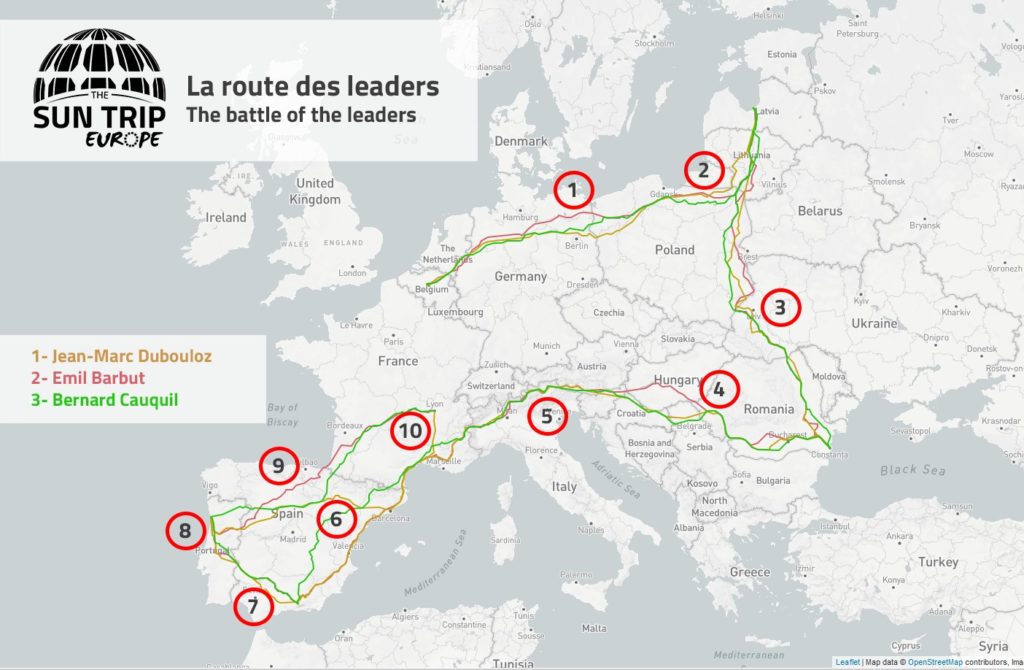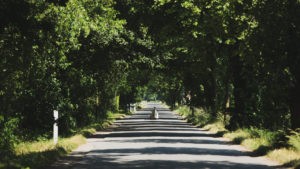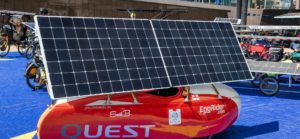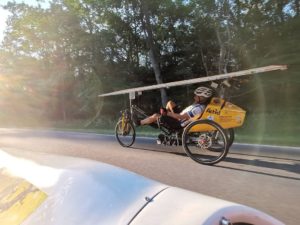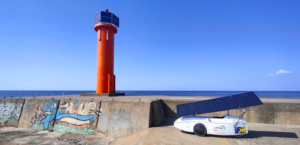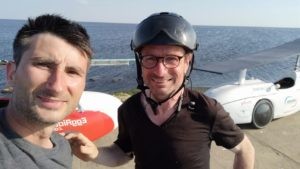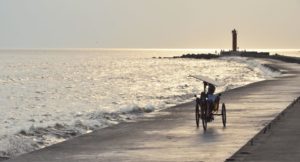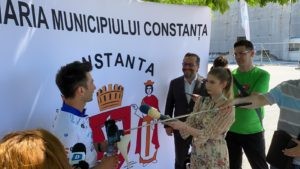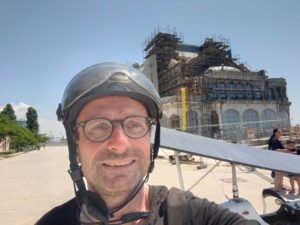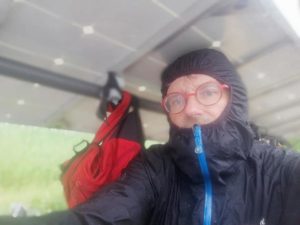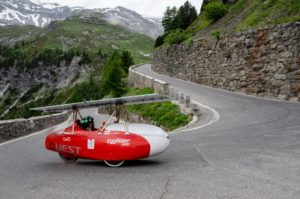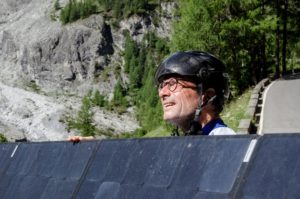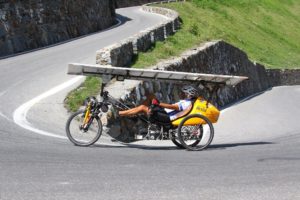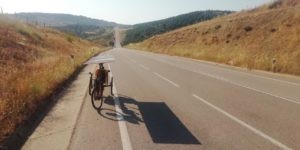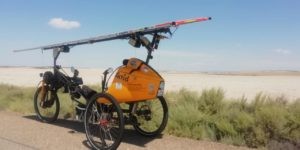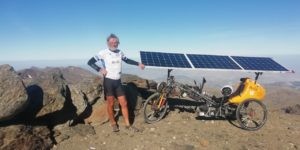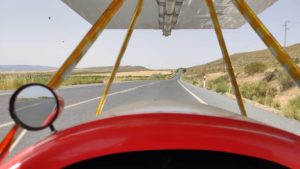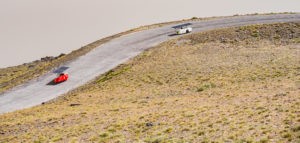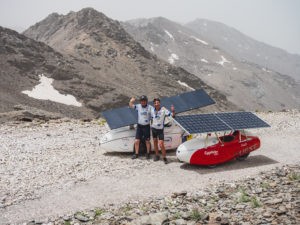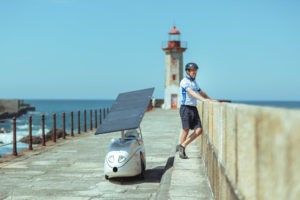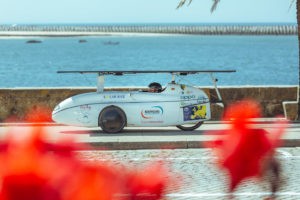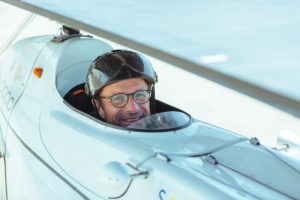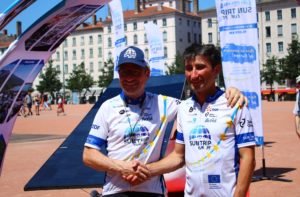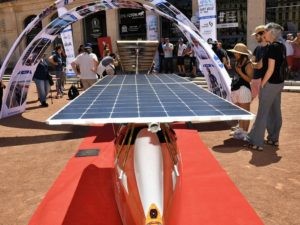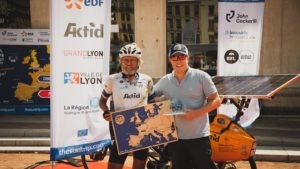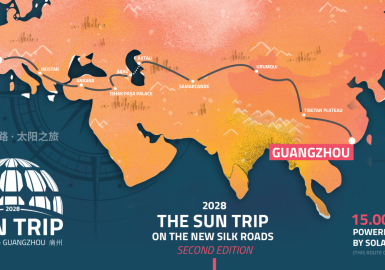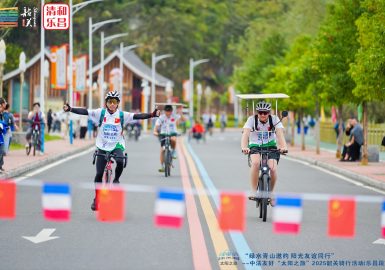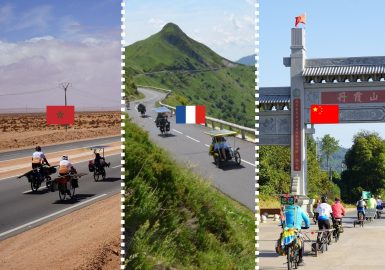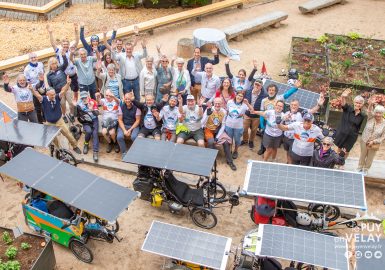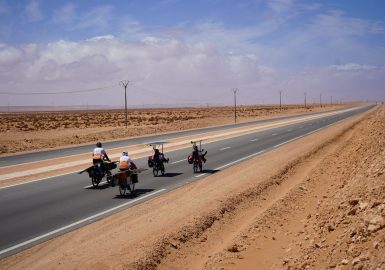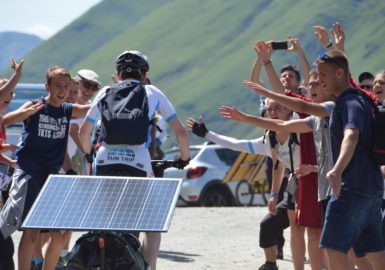The translation of this post was made automatically with Deepl.com.
The chase between Jean-Marc Dubouloz, Emil Barbut and Bernard Cauquil was certainly the highlight of this 2021 edition of the Sun Trip. Never before have we seen such a high level of performance, with the 3 leaders all breaking the records of past editions. The final daily average, 280 km in 2015 and 2018, is now 350 km for the two leaders, and 300 km for Bernard. The record of km in one day, set in 2018 at 427 km by Eric Morel, was beaten several times, by Jean-Marc and Emil, with peaks of more than 450 km between 6am and 9pm!
It is therefore exciting to take the time to analyze the course strategy of the 3 leaders, to come back on the decisive phases of the race, to deliver you some hidden details.
This analysis of the course, in 10 acts, is based on the extrapolation of the course of the 3 leaders made by Yann Cauquil, SunTripper 2018, visible on this link.
Acte 1 : Allemagne-Pologne
It is necessary firstly to remember the heat of the first days on the road, with temperatures close to 40°C. The first reflex for many, Bernard Cauquil included, is to think that the participants in velomobile will not hold the shock! “They will dehydrate quickly, the road is still long“, commented the 2015 winner, confident that he would be able to take back the cars in the 2nd part of the adventure. It is necessary to believe that Jean-Marc and Emil had good knowledge in terms of hydration!
In less than 48 hours, the leaders were approaching Berlin (Brussels-Berlin in 2 days!) and at that moment, a first race fact occurred. Jean-Marc admits to a first mistake, pulling too hard at Berlin, which Emil had carefully avoided by staying on a more direct line. Jean-Marc concludes: “In this sector, Bernard’s line was the right one in the end. I went too far south, and the next day fortunately on I slammed a 449 km, but this record will not have served to widen the gap but just to compensate for my mistake of the day before. In the middle of Poland, Emil came back to about 30 km from me“.
From the very first days, we realize that the slightest mistake will be paid for in this 2021 edition.
And for his part, Bernard has some regrets about this beginning of the adventure, “with hindsight I say to myself that I should have taken more time to work on the first days of the route. I would have decided to go through Denmark, Sweden and then Fery to reach Riga, it would have been nicer and more strategic because the beginning was too favorable to the velomobiles“.
Act 2 : the forbidden bridge?
At the beginning of the 5th day of adventure, the leaders enter Lithuania. And it’s time for the first claim of the Sun Trip 2021!
Jean-Marc (and/or his routing team) who had well prepared his route, by imagining an itinerary bordering the Russian enclave of Kaliningrad, was furious to see Emil entering Lithuania quietly, by the fastest way, leading straight to the city of Kaunas and finally on the passage of a bridge forbidden to bikes.
At the time Jean-Marc asked for a decision of the Jury, which concluded that the road taken by Emil was authorized until Marijampole, because it was obviously not a highway. This is the rule that is communicated to the participants.
But the problem was transferred to the crossing of the bridge in Kaunas the next day. The first two participants arriving there quickly realized that the only way to cross the Nemunas River to the west of the city was to cross a bridge posted as off-limits to bikes.
“I really thought I could find another solution, but the reality was that tractors and bicycles were using the bridge… There was no alternative and no apparent danger.” A statement confirmed by Bernard, then by all the other participants.
“My route was more direct on paper, but on the small roads I lost a lot of time, a loss of 2 hours in my opinion“, adds Jean-Marc, who on his return from Riga was also happy to use this bridge in Kaunas, after all.
Nevertheless, Jean-Marc must be acknowledged for being right on this occasion. The participants should have all avoided the main roads at the entrance of Lithuania, to avoid this forbidden bridge. The bad example of the first 2, validated by the lack of reaction of the jury (always very difficult in these cases), led everyone to a non-advised route. A case to keep in mind for the next Sun Trip adventures.
Act 3 : the passage to Ukraine
The passage through the Baltic countries will not bring much in the duel between the leaders. But an important act occurs when approaching Ukraine.
First of all, on day 8 Emil takes the lead for the first time. At that moment, we wonder if Jean-Marc didn’t leave the lead, by strategy, to see which Ukrainian border (the most complicated one) Emil would take, and also by elegance, to let Emil arrive in the lead in Romania, his native country. The two laughed about it together in Riga, we will never know if these good intentions played a role. Let’s leave some mystery.
Secondly, entering Ukraine was a small challenge in terms of border. Emil had to go through 3 times to find a border to cross with his bike. Jean-Marc had to be patient at 2 different border crossings. In the end, neither of them took the same border, but the gaps were neutralized on this passage. Emil stays in the lead but doesn’t gain any time on the operation.
The third act will be more decisive: the choice of roads in the south of Ukraine will bring a clear advantage to Emil: “We wanted to avoid a road known to be rotten by taking a road too far south, which made us lose 60 km on Emil who, like Bernard and the following ones, took this road without damage“, regrets Jean-Marc.
“Emil increased his lead that day in Ukraine and slept 100km further east. It was raining. The next day, he hits the good weather, which is in the East, much faster than me and flies into Romania with a nice lead that he will consolidate until Constanta“.
The observation is implacable, Jean-Marc has just lost 150 to 200 km very quickly! By the same token, we notice that Emil is perhaps more efficient in limited sunlight conditions. His machine seems to be less heavy and his pedaling is perhaps more efficient (“20 years less…” says Jean-Marc).
Behind, Bernard Cauquil, who will have less luck with the weather, continues to lose time regularly. 1 day late in Riga, a little more than 2 days in Constanta (more than 600km late), he starts to realize that the remountada will not be so easy. “If the weather stays as good for the first 2 days, it’s over for me“, he said when he arrived in Constanta, saying that he wanted to slow down a bit, to enjoy the trip more. He will still keep an exceptional rhythm until the end.
Act 4 : the Serbian shortcut
After passing checkpoint 2, Jean-Marc struggles to catch up. He is 150 to 200 km behind Emil, which will be the biggest gap between the two. On the 15th day of the journey, Emil decides to stay in the European Union countries, passing from Romania to Hungary. “It’s a choice linked to the quality of the road, but above all to the covid, I thought I needed a negative PCR test to pass to Serbia, which is outside the EU“.
Behind Jean-Marc made a different choice: “We had chosen this path before, but the fact that Emil is going North through Hungary, reinforced our choice to do different from him to open the game“.
In the end, as elsewhere, the covid did not pose any problem… and we can think that this shortcut will have allowed Jean-Marc to gain a few kilometers on Emil, who estimates that he did not lose more than one hour on the operation. But these kilometers will be very precious for Jean-Marc, to be in the wheel of the leader at the approach of the Alps and especially to arrive in the right weather timing at the Stelvio!
Act 5 : the myth of the Stelvio
If the Stelvio has been chosen to be the checkpoint 3 of the adventure, it is exactly to read this kind of story (to be found in full on this link ) !
The summer of 2021 having been more than average in the Alps, the sun was playing hide and seek as the leaders (and many other participants) passed by. Emil arrived on the slopes of the mythical pass on July 3rd, in the afternoon, with a strategy to climb as slowly as possible, using the low light to assist his pedaling a little. He finished under a cold rain, but in the end no difficulty for him. The plan was respected to the letter, with a battery not totally drained at the top of the pass. He continued on his way. At that moment he certainly hoped, secretly, to have lost the brave Jean-Marc for good.
But the same day Jean-Marc had to drive almost 14 hours in the Austrian and Italian valleys, in order to sleep at the foot of the Stelvio and hope for a break in the weather. On the morning of July 4, his plan unfolded as if by miracle, with the sun shining at 6 am, between two heavy clouds. He stayed at the campsite until about 9am before going full speed ahead on the climb. Halfway up the slope the sun was still present. It stopped for almost 2 hours to get a maximum of energy, before the clouds settled for good. At the top he almost overheated his engine, but he passed, exactly 24 hours after Emil. He knows that he will be able to recharge his batteries on the descent, thanks to his wheel engine, and he says to his direct opponent “I’m not dead, hang on Emil, nothing is over“!
We can clearly think that this episode of the Stelvio played in the morale of the two leaders. Jean-Marc was lucky with the weather, and while he could have lost a day or two on this climb (which would have been irreversible), he came out of it more motivated than ever, determined to catch up, kilometer by kilometer!
As for Bernard, he passed the Stelvio about 3 days late, but above all he made it a point of honor to prove that his machine was the most efficient in the mountains. He devised a plan to arrive with enough battery power to climb in one go, and he put on a demonstration. Where the two leaders took more than three and a half hours to climb, Bernard climbed in 1 hour and 32 minutes, which put him on par with a professional cyclist. The time is so exceptional that the Strava application will block his performance, asking Bernard to reference himself in the VAE category. We know that cycling purists are very sensitive when it comes to analyzing records!
Act 6 : Bernard king of Spain
Bernard continued on his way and decided on different itineraries than the others, in France but especially in Spain, where he cut through the middle of the country, on roads made for adventure. What’s more, he returned to Spain 4 days late and left with the same gap. This is the only part where he was able to match the velomobiles. His choices paid off and he only made a bite out of the Pico Veleta.
On this part of the course, the 2015 champion was in his element and he enjoyed himself. He only regretted that the course decided for this 2021 edition left too much room for the main roads or that the checkpoint in Portugal was not placed in the mountainous areas, which he was the first to face. He would have liked to have a more hilly course, to be able to surpass the velomobiles.
Act 7 : Battle in southern Spain
The two leaders continued their chase until the end of Spain! But as soon as they reached the south of France, Emil warned the organization of problems with his rear wheel. A problem that would make him lose time progressively, until the 24th day when a pit stop made him lose the lead, south of Valencia. At the moment of taking the lead, Jean-Marc asked if Emil needed help, then took the lead, not to lose it again.
The heat is intense in the middle of July, more than 45° in some places. The two leaders meet again on the ascent of the Pico Veleta, where Jean-Marc is caught at 2500m of altitude, a little embarrassed by a strong wind. The two decided to finish together, then to take an afternoon break in the Sierra Nevada resort, in order to avoid the heat 2000m below.
The Pico Veleta was not decisive, but the following days were. After Grenada the routes diverged and Jean-Marc, who went further south, regained an interesting advantage.
When asked about this episode, Emil regrets not having taken the time to study the roads in the south of Spain: “It’s really special there to navigate, more difficult than elsewhere, with bad roads that I should have avoided”.
Jean-Marc has a very precise memory of the day after the Pico Veleta: “I followed the trace of my router to the letter, which made me go due west, towards Lisbon, rather than Porto to the north. Many of my followers were worried at the time. But in the end, at the end of the day, I was well repositioned to the North, on the direct trajectory, with a 50 km lead over Emil. I had 3000 d+ on the counter and Emil 4000 d+!“
Act 8 : Porto !
The road to Porto is also difficult, hilly, with sometimes hole roads. Emil is progressively losing time and in Porto he has to take a few hours to repair.
The two leaders asked the organization not to impose a break on a night in Porto. “We both want to finish as soon as possible”, says Emil.
They want to go home, but the exit from Porto will surprise many! The two leaders decided to go back on their steps, on a distance of more than 100 km. Objective: avoid the mountainous areas of Northern Portugal!
Jean-Marc: “Faced with the concerns, even the almost audible cries of my followers through WhatsApp, we had chosen to communicate with Gauthier saying that I was going back to the hotel where I had forgotten my brush the night before. Afterwards, when they see Emil doing the same thing, while I go back East, Northeast, the cries fell silent.”
Emil: “This backtracking was planned, I didn’t just follow Jean-Marc. I don’t think we saved time by doing this, but on the other hand we preserved our gears, avoiding a lot of descents and holes. It was a logical strategic choice“.
Act 9 : Emil’s brilliant move
At the moment of passing Valladolid in the center of Spain, Emil is 150/200 km behind. He has never been so far from Jean-Marc.
We are at the 30th day of the adventure, the fatigue is generalized, the communications with the participants are rare. The game seems to be over, the good weather is announced for the continuation and the difficulties are over.
But Emil has not said his last word. He keeps his northern course, first to Burgos, then to the Basque Country, while Jean-Marc is already heading to Barcelona.
To everyone’s surprise, Emil decided to play poker, betting on better weather in France in the South West and then in the Massif Central, than around the Mediterranean and in the Rhone Valley: “I could see that I couldn’t catch Jean-Marc on the most logical route, so I had to try something. The wind, in particular, could play in my favor. It was a great choice in any case, I don’t regret it“.
Act 10 : the final stretch, told by Jean-Marc
With two days to go before the finish, the cards have been reshuffled! It is clearly a dream scenario for the end of the adventure. The two leaders are going all the way, driven by an emulation worthy of an ocean race.
On paper Jean-Marc has the advantage, as his course is much flatter than Emil’s. But the wind was to play a decisive role, as soon as they entered France with a strong side wind at Perpignan, then a headwind until the beginning of the Rhone Valley. Fortunately, the forecast announced the end of the wind for the arrival day. If the wind had continued to blow strongly from the front, it is not sure that the 3 hours of advance on the finish line would have been enough.
For his part, Emil achieved an incredible performance across the Massif Central. Brive la Gaillarde – Lyon in one day, that’s 350 km to complete his adventure and arrive one hour before the evening deadline (which he flirted with too often during the adventure, by the way). He didn’t think he would make it so far that his brother, living in Lausanne, Switzerland, reproached him the next day for not having warned him of a possible arrival on the same day as Jean-Marc, in which case he would have been there for the arrival!
To relive this final, we give you the story of the winner on the choice of route in Spain. A decisive moment, as if you were with him in the cockpit of his velomobile:
“For the final, my routing made me go through the western Pyrenees, the Basque country, then Toulouse, Montpellier and the Rhone Valley. In any case, I had to avoid the Massif Central and its differences in altitude.
Two days before arriving in France, the weather forecast for the South-West was bad, forcing us to think about an alternative that would be a little longer but would guarantee sunshine. The weather is always nice in summer south of the Pyrenees. We were then ready to make a last minute change.
But with one day to go, change of weather announced, the forecasts give now good weather on the South West.
That morning, of the second day in Spain, as every morning, I start at 6 am. It was still dark in Spain at that time.
It was not a morning like the others, in fact, I had only one hour to make the definitive choice of route between the South West like Emil who had already made his choice and the East of the Pyrenees where we had all returned to Spain.
Only one hour, because around 7am I cross a road; either I continue to the North towards the Basque country, or I take this road due East towards Barcelona then France. At 6:15 am while I am driving in the night, we have a meeting with the team, my 2G, Gauthier and Guillaume.
The weather forecast is finally good for the South West of France, Emil goes there.
What do I do? I remember asking them in turn “What would you do?” And getting a Norman answer. Normal for Gauthier, my neighbor in Normandy.
After 9000 km, fatigue makes us want to unload on others and pedal without thinking too much, because thinking still adds to the fatigue.
In spite of the temptation to share our fatigue, it is the interest of the Sun Trip to make us live these moments when, in spite of all the external help, the routing cell, the family, the friends, we are alone on board, in the night, alone in the world to take a decision which engages the end of the race and can be the final victory. I remember that last half hour, alone with the rising sun and this decision to make.
It was intense. My 2 G’s had left me saying, we’ll see the result of your decision at the 7:30 am reading.
I remember perfectly the inner tension rising as the deadline came. I remember perfectly the ramp that now presents itself to me at 500m, then 400, then the crossing comes… I decide to take it. Road to the East“.
—
At the end of the day, 3h15 between the first two! The equivalent of 100 km! After 11205 km of a hard fight, it is the smallest gap in the history of the Sun Trip.
The average speed is announced at 30.2 km/h on the whole, it is not so much faster than 2018, but the hours of riding are much higher: 11h40 of pedaling/day for Jean-Marc Dubouloz. These figures are also the sign of a much more tortuous course in 2021 than in 2013, 2015 and 2018. In Europe, there are few long straight lines like in the steppes of Asia and no freeways like in China. We can think that the velomobiles, launched on the same course as 2018 (quite flat in the end), would have achieved a much higher average speed.
Bernard Cauquil arrived 4 days later, a gap stabilized on all the Iberian part. Isolated in 3rd position during the whole adventure, 22 days ahead of the 4th… Bernard was able to keep the mental strength to push to the end and show that his machine was up to the task.
On his meter, an average consumption of 9.2Wh/km, where Jean-Marc shows an impressive 6.7Wh/km. “I thank Jean-Marc and Emil for going so fast, it allowed me to take a break from the race and to take the time to enjoy the adventure better“, he said at the finish, with a touch of sarcasm. At an average of 300 km per day, could the champion have really done more? On the terrain chosen for this 2021 edition, the technical capabilities of his machine did not allow for more. What would it be like on a European course where each checkpoint would lead to crossing a mountain range? Perhaps the future will tell us.
In any case, the performance of the velomobiles will have marked the history of the Sun Trip and of solar mobility. We must be congratulated, impressed, and dream about it. In 100 years, solar mobility may have taken over, but today 11,000 km in 33 days is just magic!
The solar adventure has only just begun.
Florian Bailly – Founder of the Sun Trip
